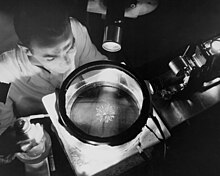
The rules are the most popular measuring instruments.

Diameter measurement with a caliber
A measuring instrument is a tool used to measure a physical quantity. Measurement is the process that allows obtaining and comparing physical quantities of objects and phenomena in the real world. As units of measurement, objects and events previously established as standards or patterns are used, and the measurement results in a number that is the relationship between the object of study and the reference unit. Measuring instruments are the means by which this logical conversion is done. The action taken to obtain the data is measurement, and the entire process of comparing it with defined patterns is known as measurement.
Main features
The important characteristics of a measuring instrument are:
- Precision: is the ability of an instrument to give the same result in different measurements performed in the same conditions.
- Exactity: degree of approach of the measures of an amount to the true value of that amount.
- Resolution: it is the minimum variation of the magnitude that can be measured with the measure instrument indicated.
- Appreciation: is the smallest measure perceptible in a measuring instrument.
- Sensitivity: is the displacement ratio between the measurement indicator of the instrument used and the actual measure.
Instruments
A great variety of instruments are used to carry out these measurements of the different physical magnitudes that exist. From simple objects like rulers and stopwatches to electron microscopes and particle accelerators.
The following are some existing measurement instruments based on the magnitude they measure:
To measure mass: - Balanza
- Báscula
- Mass spectrometer
- Catameter
To measure time: - Calendar
- Chronometer
- Sand clock
- Clock
- Atomic watch
- Radiometric data
- Timeline
To measure length: - Metric tape.
- Rule.
- Calibre, also called foot of king or calibre vernier
- Micrometer, also called Palmer screw
- Comparative watch
- Interferometer
- Odometer
To measure angles: - Goniometer
- Sixth
- Carrier
- Cylometer
To measure temperature: - Thermometer
- Thermocouple
- Pyrometer
To measure pressure: - Barometer
- Memometer
- Pitot tube
To measure speed: - Speed
- Anemmeter (measure wind speed)
- Tachometer (mode the turning speed of a shaft)
To measure electrical properties: - Electrometer (low load)
- Amperimeter (mould electric current)
- Galvanometer (low current)
- oohmeter (mide resistance)
- Voltmeter (lower voltage)
- Vatmeter (lower power)
- Finemeter (mide all previous values)
- Osciloscope
To measure volumes - Pipeta
- Probeta
- Bureta
- Matraz strengthened
To measure weight - Diameter
- Báscula
- Barometer
- Rainfall
- Catameter
To measure ionizing radiation The ionizing radiation includes both "particle" rays and "wave" rays. Especially X-rays and gamma-rays transfer enough energy into non-thermal collision (simples) processes to separate electrons from an atom.
 A fog camera that detects alpha rays. - Particle and lightning flow
- House of bubbles
- House of fog
- Dosimeter, technical device that performs different operating principles.
- Accountant Geiger
- ionization chamber
- Microchannel Plate Detector (Microchannel Plate Detector)
- Photographic plaque
- Photo-stimulable phosphorus plate
- Proportional counter
- Flame counter, Lucas cell
- Semiconductor detector
To measure other quantities: - Caudalmeter, used to measure the flow of a fluid in a pipe
- Colorimeter
- Spectroscope
- Spectrometer
- Nichols radiometer
- Seismographer
- Potentometer, also called pH-meter, measures the hydrogen potential of a solution
- Pirhelimeter
- Luxometer, measure lighting level)
- Sonometer, measure sound pressure levels
- Diameter, measure strength
- Hygrometer, measure relative humidity in the air
- Psychometer, measure relative humidity in the air more accurately than hygrometers, using the temperature difference between a thermometer with the dry bulb and another with the wet bulb
|
Más resultados...


